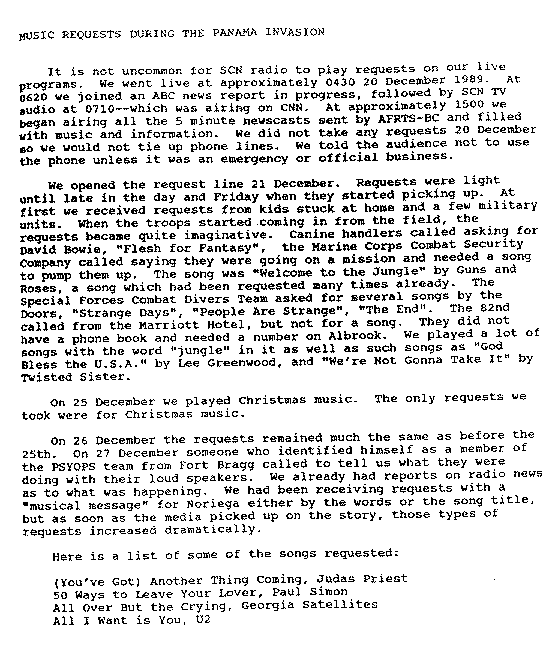When Manuel Noriega Was Forced From The Sanctuary Of The Vatican Embassy By The Power Of Rock
- dthholland

- Jan 3
- 5 min read

In the history of U.S. military interventions, few operations have combined tactical precision, high-stakes drama, and surreal psychological warfare as effectively as Operation Nifty Package. This daring mission, launched as part of Operation Just Cause in Panama in December 1989, aimed to capture Manuel Noriega, the country’s military dictator and a former U.S. ally turned international pariah. From Navy SEALs sabotaging Noriega’s escape routes to an intense standoff at the Vatican’s embassy in Panama City, the operation offers a gripping study in modern military strategy, human ingenuity, and the chaos of war.
The SEAL Team 4 Mission at Punta Paitilla Airport
In the early hours of 20 December 1989, SEAL Team 4 embarked on a high-risk mission at Punta Paitilla Airport. The operation involved 48 Navy SEALs, divided into three platoons—Golf, Bravo, and Delta—under the leadership of Lt. Cmdr. Patrick Toohey, a seasoned officer with ties to SEAL Team Six. The team’s objective was to disable Noriega’s private jet, a 1980 Learjet 35 (registration N930GL), preventing him from fleeing Panama.

Reconnaissance teams, hidden near the airfield, had been observing enemy movements, providing real-time updates to the SEALs. The main force landed south of the airport at approximately 0030, just as the wider combat operations in Panama City commenced. Shortly after establishing a command post near the southern edge of the runway, Toohey received a directive from Cmdr.
McGrath, stationed offshore, to damage the Learjet with minimal destruction—targeting its tyres and control wires instead of destroying it outright. This last-minute change forced the SEALs to alter their tactics, requiring a closer approach to the aircraft and increasing their exposure to enemy fire.

By 0105, Golf Platoon was in assault positions outside the hangar housing the Learjet. However, as they prepared to move, Panamanian Defence Forces (PDF) troops opened fire, leading to a chaotic engagement. The SEALs sustained heavy casualties, with two killed and five wounded in the initial exchange. Reinforcements from Bravo and Delta platoons arrived, enabling the SEALs to secure the airfield. The Learjet was ultimately neutralised using an AT4 anti-tank weapon, ensuring Noriega could not use it for escape.
Despite the operation’s success, it came at a high cost: four SEALs were killed, and nine were wounded. The SEALs held the airport through the night, disabling the runway by rolling aircraft onto it. By morning, the 75th Ranger Regiment relieved the SEALs, marking the end of the controversial Battle of Paitilla Airport. The operation remains a subject of scrutiny within the U.S. military, with debates over the planning, execution, and high casualty rate.
Sabotage of Presidente Porras
While SEAL Team 4 targeted the airport, another group from SEAL Team 2 carried out a simultaneous mission to neutralise Noriega’s heavily armed gunboat, the Presidente Porras. The 65-foot aluminium craft, built in Louisiana in 1982 by Swiftships, was moored at a pier on the Panama Canal. The team consisted of four combat swimmers equipped with Dräeger rebreathers, allowing them to approach undetected.
Under cover of darkness, the divers reached the boat after launching from Zodiac inflatable rafts. They attached explosives to the vessel’s hull, but their presence was detected before they could exfiltrate. PDF guards dropped grenades and fired into the water, forcing the divers to take cover beneath the pier. Despite the danger, the team confirmed the destruction of the Presidente Porras as the explosives detonated.
Their retreat was equally perilous. A passing ship forced the divers to descend to dangerous depths, pushing the limits of their oxygen systems. Fortunately, all team members returned safely to their extraction point at Rodman Naval Base.
The Standoff at the Apostolic Nunciature
The most dramatic chapter of Operation Nifty Package began when Noriega sought refuge at the Apostolic Nunciature, the Vatican’s embassy in Panama City. On 24 December, five days into the U.S. invasion, Noriega telephoned Monsignor Jose Sebastian Laboa, requesting sanctuary. Laboa agreed, but later admitted his primary goal was to persuade Noriega to surrender.

Noriega entered the Nunciature with four associates, including Lieutenant Colonel Nivaldo Madrinan and Captain Eliecer Gaitan, two key figures in his regime. They turned over their weapons and spent their time confined in the stark conditions of the embassy. Noriega reportedly read the Bible daily, while outside, U.S. forces established a perimeter to prevent his escape.
Direct military action against the Nunciature was prohibited by international law, so the U.S. Army resorted to psychological warfare. The US military opted for psychological warfare by continuously playing a barrage of loud rock music outside. Humvees equipped with loudspeakers rolled in, featuring a playlist from the Southern Command Network, including songs like "I Fought The Law" by The Clash, "Panama" by Van Halen, U2's "All I Want Is You," and Bruce Cockburn's "If I Had A Rocket Launcher," Ricky Nelson’s “Poor Little Fool” to “You Shook Me All Night Long” by AC/DC
The full list has been saved for posterity in The George Washington University's National Security Archive (pages 4,5 and 6), while parts of it are available on YouTube.
Perhaps inevitably, The Holy See complained to President Bush, and the musical war was stopped after three days.
Noriega asked permission to phone his wife and three daughters, who had taken refuge in the Cuban embassy; he was assured that they would be flown to exile in the Dominican Republic if he surrendered
On 3 January, Noriega attended Holy Mass in the Nuncio's chapel and took communion; where Laboa's homily was about the thief on the cross who in one moment asked God to change his life, and reportedly brought tears to Noriega's eyes.
After Mass, Noriega retired to his room where he wrote two letters, one to his wife informing her "I go now on an adventure", and the other thanking the Pope and stressing that he believed himself innocent and that he had always acted in the best interests of the Panamanian people and requesting the Pope's prayers.

Noriega dressed in his tan uniform, receiving permission to bring the Nuncio's Bible with him, and went outside into the dark night with three priests who walked with him the fifty paces to the front gate; when he reached the front gate, an American paratrooper named Sgt. Scott Geist confronted Noriega and described him as "a broken man". A number of other soldiers then forced him to the ground and began searching his effects. His wrists were taped behind his back and was led into a waiting American helicopter which took him to Howard Air Force Base.
Noriega was flown to Howard Air Force Base before being extradited to the United States. There, he faced trial and was convicted on charges of drug trafficking, racketeering, and money laundering. His arrest marked the end of an era for Panama and a significant victory for U.S. forces, though the operation remained a subject of debate for its methods and cost.
Monsignor Laboa later told the press that he was proud at having "outwitted" Noriega and convincing him to surrender himself to the Americans, noting "I'm better at psychology"

The United Nations and the European Court of Human Rights have since banned the use of loud music in interrogations. The human rights group Amnesty International counts it as a method of torture.
And as for Noriega? he spent the rest of his life in custody - first in the US, then France and finally under house arrest in Panama. He died in 2017, aged 83, as a result of complications from an operation to remove a brain tumour.
















































































































